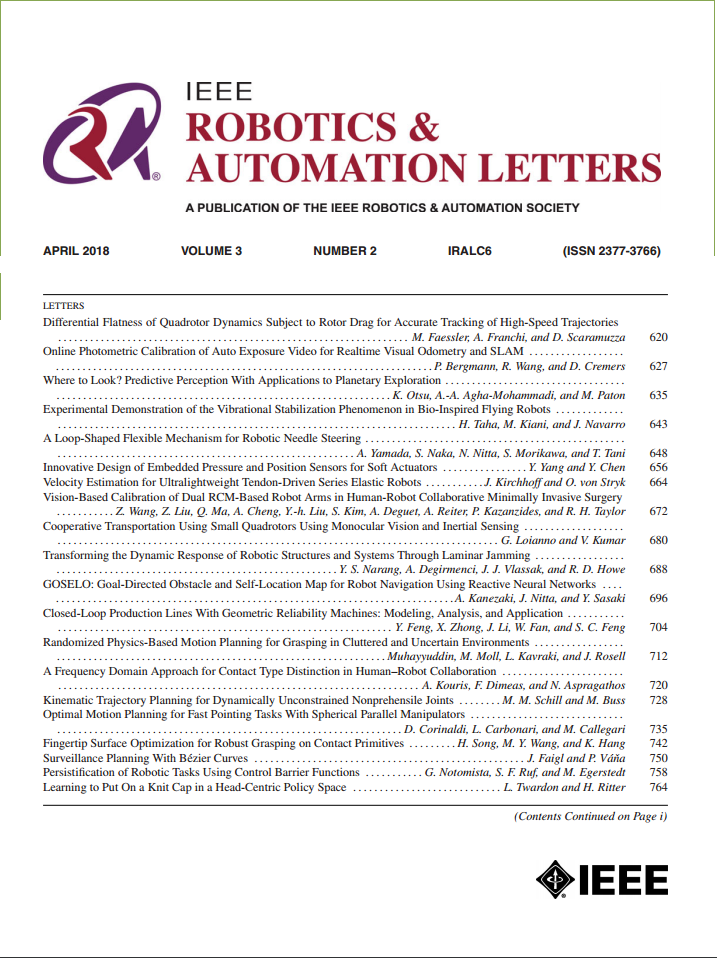基于仿生软光学触觉传感器的数据驱动顺应性判别:基于模型方法的实现和基准测试
IF 5.3
2区 计算机科学
Q2 ROBOTICS
引用次数: 0
摘要
人类可以很容易地操纵柔软的、可变形的物体,依靠他们的指垫固有的可变形性和他们推断物体顺应性的能力。将这些技能转移到机器人系统中仍然是一项具有挑战性的任务。最近,软仿生触觉传感器的引入,如旨在模仿人类皮肤层结构的tactical,代表了弥合这一差距的尝试。然而,尽管在赋予人工系统具有生物感知的具身智能方面取得了进展,但依从性估计的计算方面仍在很大程度上未被探索,主要依赖于数据驱动(DD)方法。在之前的一项工作中[Pagnanelli, et al.(2023)],提出了一种基于模型的方法,通过将tactical与人类触觉感知的计算模型相结合来进行依从性估计。然而,这两类技术都存在局限性(模型启发的一般化问题;(DD的数据诅咒),这表明混合方法可能是更合适的解决方案。探索混合框架可行性的第一步是开发鲁棒神经网络架构,然后根据分析方法获得的结果对其进行基准测试。通过这种方式,我们可以评估它们的互补优势和潜在的整合。这项工作通过使用深度学习技术,提出了一种通过tactical进行合规评估的新方法,专门解决了这一步骤。验证了神经网络架构,并将其性能与我们先前开发的基于模型的方法进行了比较分析。本文章由计算机程序翻译,如有差异,请以英文原文为准。
Data-Driven Compliance Discrimination via Biomimetic Soft Optical Tactile Sensors: Implementation and Benchmarking With a Model-Based Approach
Humans can easily manipulate soft, deformable objects, relying on the intrinsic deformability of theirfingerpads and their capabilities to infer item compliance. Transferring these skills into robotic systems is still an open challenging task. Recently, the introduction of soft biomimetic tactile sensors such as the TacTip, which aims at mimicking the structure of human skin layers, has represented an attempt to bridge this gap. However, while the advancement in endowing artificial systems with bio-aware embodied intelligence, the computational aspects of compliance estimation are still largely unexplored, mostly relying on Data-Driven (DD) methods. In a previous work [Pagnanelli, et al. (2023)], a model-based approach to compliance estimation by combining TacTip with a computational model of human tactile perception has been proposed. However, both these categories of techniques suffer from limitations (generalizability issues for the model-inspired; the curse of data for DD), suggesting that a hybrid approach could represent a more suitable solution. The first step in exploring the feasibility of a hybrid framework is to develop robust neural network architectures and then benchmark them against the results achieved through the analytical method. In this manner, we can assess their complementary strengths and potential integration. This work specifically addresses this step by proposing a novel approach for compliance estimation via TacTip using deep learning techniques. The neural network architecture was validated, and a comparative analysis of its performance against our previously developed model-based approach was performed.
求助全文
通过发布文献求助,成功后即可免费获取论文全文。
去求助
来源期刊

IEEE Robotics and Automation Letters
Computer Science-Computer Science Applications
CiteScore
9.60
自引率
15.40%
发文量
1428
期刊介绍:
The scope of this journal is to publish peer-reviewed articles that provide a timely and concise account of innovative research ideas and application results, reporting significant theoretical findings and application case studies in areas of robotics and automation.
 求助内容:
求助内容: 应助结果提醒方式:
应助结果提醒方式:


